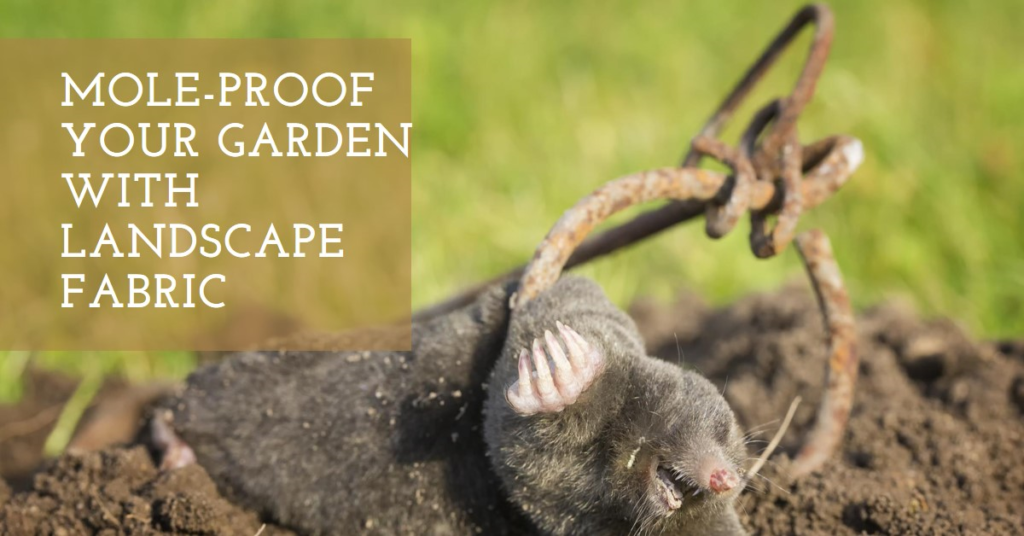
Table of Contents
- Introduction: The Persistent Problem of Moles
- Understanding Moles: Behavior and Impact
- What is Landscape Fabric?
- Evaluating Landscape Fabric as a Mole Barrier
- Installation Best Practices
- Benefits Beyond Mole Control
- Limitations of Landscape Fabric
- Alternative Mole Control Methods
- Integrating Multiple Strategies
- Conclusion: A Balanced Approach to Mole Control
Introduction: The Persistent Problem of Moles
Moles can wreak havoc in a garden, leaving a trail of destruction that frustrates even the most patient gardeners. These subterranean pests create unsightly mounds and tunnels, uprooting plants and disrupting root systems. In the quest for an effective solution, many gardeners turn to landscape fabric, hoping it will serve as a barrier against these burrowing invaders. But does landscape fabric really keep moles out of your garden? This blog post delves into the efficacy of landscape fabric as a mole deterrent, exploring its benefits, limitations, and alternative solutions.
Understanding Moles: Behavior and Impact
Before evaluating the effectiveness of landscape fabric, it’s essential to understand moles and their behavior. Moles are insectivorous mammals that live underground, creating extensive tunnel systems in search of food such as earthworms, grubs, and insects. They rarely come to the surface, making their presence known primarily through the damage they cause.
The impact of moles in a garden can be significant. Their tunneling disrupts the soil structure, which can damage plant roots and lead to poor plant health. Additionally, molehills can create an uneven garden surface, making mowing and other garden activities challenging. Understanding these behaviors helps in formulating strategies to mitigate their impact.
What is Landscape Fabric?
Landscape fabric, also known as weed barrier fabric, is a geotextile used in gardening and landscaping to control weed growth. It’s made from woven or non-woven materials that allow water and nutrients to pass through while blocking sunlight, which prevents weeds from germinating and growing. Landscape fabric is typically laid on the soil surface and covered with mulch or gravel.
Gardeners appreciate landscape fabric for its ability to reduce the need for chemical weed control and minimize manual weeding. Its primary purpose is to maintain a clean and weed-free garden bed, but it’s also marketed for other benefits, such as moisture retention and soil temperature regulation. However, its effectiveness against moles is less clear and warrants closer examination.
Evaluating Landscape Fabric as a Mole Barrier
The idea behind using landscape fabric as a mole barrier is that it creates a physical obstruction that moles cannot penetrate. The fabric is installed beneath the soil or mulch, theoretically preventing moles from reaching the surface or moving freely through the garden. However, several factors determine its effectiveness.
First, the material and thickness of the landscape fabric play a crucial role. Lightweight, porous fabrics may not withstand the digging efforts of moles, while heavier, more robust fabrics might provide a better deterrent. Additionally, the installation process is critical; gaps, overlaps, or improper anchoring can provide entry points for moles.
Second, moles are known for their persistence and ability to navigate around obstacles. Even with landscape fabric in place, moles may find ways to bypass it, especially if the fabric does not cover the entire area thoroughly. Thus, while landscape fabric might slow down moles or reduce their activity in specific sections, it is unlikely to be a foolproof solution on its own.
Installation Best Practices
To maximize the potential of landscape fabric as a mole deterrent, proper installation is key. Here are some best practices to consider:
- Choose the Right Fabric: Opt for a heavy-duty, non-woven fabric that is resistant to tearing and puncturing. This type of fabric is more likely to withstand the pressure and digging efforts of moles.
- Prepare the Ground: Clear the area of any existing weeds, rocks, and debris. Ensure the soil is level and compact to create a stable base for the fabric.
- Overlap Edges: When laying the fabric, overlap the edges by at least 6 inches to prevent moles from finding gaps. Secure the fabric with landscape staples or pins every few feet.
- Cover with Mulch: Once the fabric is in place, cover it with a thick layer of mulch or gravel. This adds an additional layer of protection and helps keep the fabric anchored.
By following these steps, gardeners can enhance the effectiveness of landscape fabric, although it should not be the sole strategy for mole control.


Benefits Beyond Mole Control
While the primary focus here is on mole control, it’s worth noting the additional benefits landscape fabric offers. Its ability to suppress weed growth can significantly reduce the labor and time required for garden maintenance. By blocking sunlight, it prevents weed seeds from germinating, which helps maintain a neat and tidy garden bed.
Furthermore, landscape fabric can help retain soil moisture by reducing evaporation. This is particularly beneficial during hot, dry periods, as it ensures plants receive adequate water without the need for frequent irrigation. The fabric also moderates soil temperature, protecting plant roots from extreme temperature fluctuations.
Limitations of Landscape Fabric
Despite its advantages, landscape fabric has several limitations, especially concerning mole control. As mentioned earlier, its effectiveness depends heavily on the type and installation quality. Even then, moles may still find ways to navigate around or beneath the fabric.
Additionally, landscape fabric can hinder soil health over time. While it allows water and nutrients to pass through, it can also restrict the natural movement of soil organisms and limit the exchange of gases between the soil and the atmosphere. This can lead to compaction and reduced soil fertility, affecting plant growth in the long term.
Moreover, the fabric can degrade over time, especially when exposed to sunlight and moisture. This degradation reduces its effectiveness and necessitates replacement, adding to maintenance costs. Therefore, while landscape fabric can be a valuable tool in garden management, it should be used with consideration of these limitations.
Alternative Mole Control Methods
Given the limitations of landscape fabric, it’s prudent to explore alternative methods for mole control. Here are a few effective strategies:
- Physical Barriers: Installing underground barriers made of metal or plastic can prevent moles from entering garden areas. These barriers should be buried at least 24 inches deep and extend 6 inches above the ground.
- Mole Repellents: Natural and chemical repellents can deter moles from specific areas. Castor oil-based repellents are popular and can be applied to the soil to create an unpleasant environment for moles.
- Trapping: Setting up mole traps is a direct and effective way to reduce mole populations. Various traps are available, including humane options that allow for the relocation of captured moles.
- Encouraging Predators: Attracting natural predators such as owls, hawks, and snakes can help control mole populations. Creating a habitat that supports these predators can be a long-term solution.
Integrating Multiple Strategies
For comprehensive mole control, integrating multiple strategies is often the best approach. Combining landscape fabric with other methods can enhance overall effectiveness. For example, using landscape fabric alongside underground barriers and repellents can create multiple layers of defense against moles.
Additionally, regular garden maintenance and monitoring are crucial. Keeping the garden clean and free of debris reduces the attractiveness of the area to moles. Regularly inspecting the garden for signs of mole activity allows for timely intervention before the problem escalates.
Conclusion: A Balanced Approach to Mole Control
While landscape fabric offers several benefits, its role in mole control is limited and should not be relied upon as a standalone solution. Understanding the behavior and impact of moles, along with the proper installation of landscape fabric, can enhance its effectiveness. However, integrating multiple control methods and maintaining diligent garden care are essential for sustainable mole management.
By adopting a balanced approach that combines landscape fabric with physical barriers, repellents, trapping, and predator encouragement, gardeners can protect their gardens from the persistent problem of moles. This comprehensive strategy ensures a healthy, thriving garden free from the disruptive presence of these burrowing pests.


